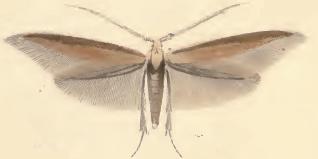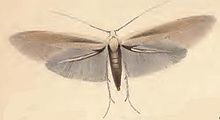
Lamium (dead-nettles) is a genus of about 30 species of flowering plants in the family Lamiaceae, of which it is the type genus. They are all herbaceous plants native to Europe, Asia, and northern Africa, but several have become very successful weeds of crop fields and are now widely naturalised across much of the temperate world.

Stachys is a genus of plants, one of the largest in the mint family Lamiaceae. Estimates of the number of species vary from about 300, to about 450. Stachys is in the subfamily Lamioideae and its type species is Stachys sylvatica. The precise extent of the genus and its relationship to other genera in the subfamily are poorly known.

Coleophora limosipennella is a moth of the family Coleophoridae described by Philogène Auguste Joseph Duponchel in 1843. It is found in Europe from Fennoscandia to the Pyrenees, Italy and the Balkan Peninsula and from Great Britain to the Baltic States and Romania. It is an introduced species in North America.

The gold spangle is a moth of the family Noctuidae. The species was first described by Michael Denis and Ignaz Schiffermüller in 1775. It is found in Europe, across western Siberia and the Altai Mountains, the northern Caucasus, northern Turkey and northern Iran.

Autographa jota, commonly known as plain golden Y, is a moth of the family Noctuidae. The nominate form is found in Europe. while the subspecies Autographa jota anatolica is found in the southern Balkans, south-western Asia, Turkey, the Caucasus, and north-western Iran.

Endothenia quadrimaculana is a moth of the family Tortricidae. It is found from northern and central Europe to Siberia and south-eastern Russia, Mongolia and China. Subspecies nubilana is found in North America.
Agdistis heydeni is a moth of the family Pterophoridae. It is known from western Asia, southern Europe, Hungary, Poland, North Africa and the Canary Islands.

Stagonomus venustissimus, common name woundwort shieldbug, is a species of shieldbug belonging to the family Pentatomidae, subfamily Pentatominae.

Coleophora albitarsella is a moth of the family Coleophoridae. It is found in most of Europe, but has not been recorded from Ireland and Greece.

Coleophora wockeella is a moth of the family Coleophoridae. It is found from Latvia to the Iberian Peninsula, Italy and Albania and from Great Britain to southern Russia.

Coleophora virgatella is a moth of the family Coleophoridae. It is found from Germany and Poland to the Pyrenees, Italy and Greece. It has also been recorded from southern Russia and central Asia.

Coleophora auricella is a moth of the family Coleophoridae. It is found from Germany and Poland to Spain, Italy and Romania. It has also been recorded from southern Russia.
Coleophora ballotella is a moth of the family Coleophoridae. It is found from Germany, Poland and the Baltic States to the Iberian Peninsula, Italy and Greece. It has also been recorded from northern and southern Russia.

Coleophora lineolea is a moth of the family Coleophoridae. It is found in most of Europe.
Coleophora onopordiella is a moth of the family Coleophoridae. It is found in France and Italy, and from Poland to Greece.
Coleophora stachydis is a moth of the family Coleophoridae that is endemic to Afghanistan.

Stagmatophora heydeniella is a moth in the family Cosmopterigidae. It is found in France, Germany, Switzerland, Austria, Italy, the Czech Republic, Poland, Slovakia, Hungary, Romania, North Macedonia, Ukraine and Russia.

Phenylethanoids are a type of phenolic compounds characterized by a phenethyl alcohol structure. Tyrosol and hydroxytyrosol are examples of such compounds.

Endothenia nigricostana, the black-edged marble, is a moth of the family Tortricidae. It was described by Adrian Hardy Haworth in 1811. It is found from most of Europe, east to Japan. The habitat consists of woodland margins and embankments.












